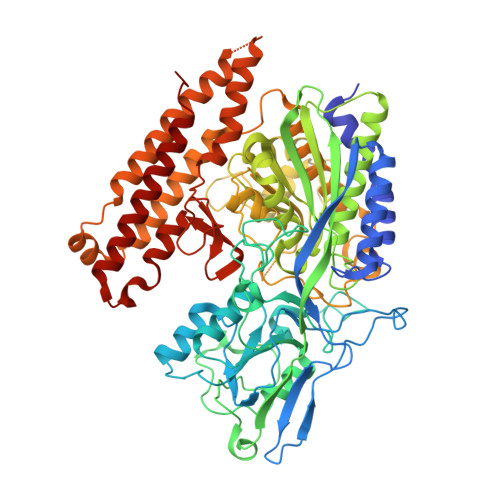Structural, Biochemical, and Computational Characterization of Sulfamides as Bimetallic Peptidase Inhibitors.
Novakova, Z., Tehrani, Z.A., Jurok, R., Motlova, L., Kutil, Z., Pavlicek, J., Shukla, S., Choy, C.J., Havlinova, B., Baranova, P., Berkman, C.E., Kuchar, M., Cerny, J., Barinka, C.(2024) J Chem Inf Model
- PubMed: 38224368
- DOI: https://doi.org/10.1021/acs.jcim.3c01542
- Primary Citation of Related Structures:
4W9Y, 6SGP, 6SKH - PubMed Abstract:
The sulfonamide function is used extensively as a general building block in various inhibitory scaffolds and, more specifically, as a zinc-binding group (ZBG) of metalloenzyme inhibitors. Here, we provide biochemical, structural, and computational characterization of a metallopeptidase in complex with inhibitors, where the mono- and bisubstituted sulfamide functions are designed to directly engage zinc ions of a bimetallic enzyme site. Structural data showed that while monosubstituted sulfamides coordinate active-site zinc ions via the free negatively charged amino group in a canonical manner, their bisubstituted counterparts adopt an atypical binding pattern divergent from expected positioning of corresponding tetrahedral reaction intermediates. Accompanying quantum mechanics calculations revealed that electroneutrality of the sulfamide function is a major factor contributing to the markedly lower potency of bisubstituted compounds by considerably lowering their interaction energy with the enzyme. Overall, while bisubstituted uncharged sulfamide functions can bolster favorable pharmacological properties of a given inhibitor, their use as ZBGs in metalloenzyme inhibitors might be less advantageous due to their suboptimal metal-ligand properties.
Organizational Affiliation:
Institute of Biotechnology of the Czech Academy of Sciences, BIOCEV, Prumyslova 595, 252 50 Vestec, Czech Republic.





















